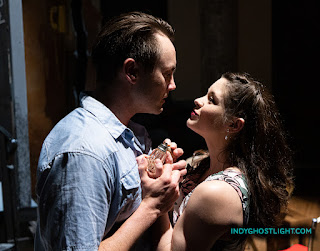First night of IVCI classical finals: Three faces of Mozart's Violin Concerto No. 5 in A major
By intermission Wednesday, any fears of a certain sameness to the first night of Classical Concerto Finals had been banished. There was no need to worry about sitting through three performances of Mozart's Violin Concerto No. 5 in A major, K. 219, based on the first two.
By the end of the concert, the audience in Lilly Performance Hall at the University of Indianapolis' DeHaan Fine Arts Center had received three distinct perspectives on the work from Tessa Lark, Jinjoo Cho, and Ji Yoon Lee, accompanied by the East Coast Chamber Orchestra.
Participants in the International Violin Competition of Indianapolis had the choice of five Mozart concertos, the last four of them written in 1775, and Joseph Haydn's C major concerto. As often happens, certain selections dominate in each of the repertoire categories. This year, that means that among the finalists, four chose K. 219, sometimes called "the Turkish," and two of them prepared the Mozart D major, K. 218.
Tessa Lark's performance had the pluses and minuses associated with first impressions: She had the
advantage of setting the tone for the evening's interpretations, with the drawback that her fellow competitors could be viewed as offering a corrective.
Her playing was powerful and straightforward, but not routine. Repeated phrases were tastefully varied in articulation, and her ornaments were restrained. There was vigor and freshness in her cadenzas, which were new to me, perhaps original with her. She seemed to have thought thoroughly about the work. It was an astute, generously expressive, and well-balanced rendition. The touches of novelty in the finale that make this concerto so attractive — including the "Turkish" episode that brings wildness to the Rondo — were suitably acknowledged by soloist and ensemble alike.
Revelations of a not entirely welcome kind entered the concert with Jinjoo Cho's performance. She had strong ideas, too. In comparison with Lark, the violin's Adagio entrance was slower, the succeeding Allegro aperto a mite faster. She stumbled at one point before the cadenza — the predominant one (since Mozart left none of his own) by Joseph Joachim. This had more pauses, more lingering phrases than usual, and I began to feel a haze of distortion descend over her performance.
She detached from each other the two-note units that make up the main phrase of the second movement's theme, an affectation that impeded the melody's flow. Scholars say that the "Adagio" indication is rare in Mozart, so it's not a sin to dawdle, perhaps. But too much of a dawdling feeling characterized Cho's performance, dreamy and delicate to a fault.
In the finale, her cadenzas tended to finish awkwardly. There was otherwise considerable polish to her playing, but I didn't think the movement's expressive variety was fully felt. Mozart biographer Maynard Solomon has written about the "serenade style" that influenced these concertos — the composer's evolution of the social music of divertimentos, cassations, and serenades into something more searching. "He cannot help probing," Solomon writes, "beyond the gentle longings of the serenader, who keeps his darker passions at bay, hidden within the lulling rhythms of the simulated lute accompaniment."
More understanding of what the 19-year-old composer, exercising his genius within the forms and norms of provincial Salzburg, was doing in this concerto was needed in Cho's performance. Something of this understanding became evident with Ji Yoon Lee after intermission. For one thing, she reined in the anachronistic aspects of Joachim's cadenzas, making them idiomatic to the 18th century, and she always finished them gracefully.
She exemplified the odd quality called for in the first-movement tempo designation — aperto, meaning "open" — with a dancing, optimistic approach. Her own youthful vigor, joined to the composer's, led her to several "pushed" phrases that came close to running ahead of the orchestra. On the whole, however, Lee seemed to inspire the easy-to-inspire East Coast Chamber Orchestra to even more rhythmic resilience and definitive sparkle. Together, they attained what Michael Steinberg described as hearing in this music — "Beechamesque swagger" (referring to the ebullience characteristic of the 20th-century English conductor Sir Thomas Beecham).
The serenade style's roots in dance and accessible melodies prevailed. Lee's second-movement playing didn't segment the solo line as Cho had done. Her slow playing never plodded. In the finale, she and the orchestra didn't wait until the "Turkish" section to emphasize the music's richness of invention, including the "darker passions" Solomon alluded to in the serenade style Mozart inherited. The finale's minuet basis was both honored and transformed.
In sum, Lee's performance of this piece is the sort I prefer to hear in concert, ignoring the competitive context. Lark's was the sort that wins competitions; it had "victory" written all over it, and its violinistic display was impeccable. Cho's, while not unprofessional, seemed wrongheaded on several counts.
This astonishing three-way contest was introduced by ECCO's winsome playing, conductorless as always, of Jennifer Higdon's "String." The work distributes some lively pizzicato phrases among the sections until a flowing episode takes over. Before long, it's off to the races with a kind of saltarello in an easy-on-the-ears gallop to the final measure. This amounted to a zesty curtain-raiser for three intriguing ways of looking at a single Mozart work.
By the end of the concert, the audience in Lilly Performance Hall at the University of Indianapolis' DeHaan Fine Arts Center had received three distinct perspectives on the work from Tessa Lark, Jinjoo Cho, and Ji Yoon Lee, accompanied by the East Coast Chamber Orchestra.
Participants in the International Violin Competition of Indianapolis had the choice of five Mozart concertos, the last four of them written in 1775, and Joseph Haydn's C major concerto. As often happens, certain selections dominate in each of the repertoire categories. This year, that means that among the finalists, four chose K. 219, sometimes called "the Turkish," and two of them prepared the Mozart D major, K. 218.
Tessa Lark's performance had the pluses and minuses associated with first impressions: She had the
advantage of setting the tone for the evening's interpretations, with the drawback that her fellow competitors could be viewed as offering a corrective.
 |
| Tessa Lark Jinjoo Cho |
Revelations of a not entirely welcome kind entered the concert with Jinjoo Cho's performance. She had strong ideas, too. In comparison with Lark, the violin's Adagio entrance was slower, the succeeding Allegro aperto a mite faster. She stumbled at one point before the cadenza — the predominant one (since Mozart left none of his own) by Joseph Joachim. This had more pauses, more lingering phrases than usual, and I began to feel a haze of distortion descend over her performance.
She detached from each other the two-note units that make up the main phrase of the second movement's theme, an affectation that impeded the melody's flow. Scholars say that the "Adagio" indication is rare in Mozart, so it's not a sin to dawdle, perhaps. But too much of a dawdling feeling characterized Cho's performance, dreamy and delicate to a fault.
In the finale, her cadenzas tended to finish awkwardly. There was otherwise considerable polish to her playing, but I didn't think the movement's expressive variety was fully felt. Mozart biographer Maynard Solomon has written about the "serenade style" that influenced these concertos — the composer's evolution of the social music of divertimentos, cassations, and serenades into something more searching. "He cannot help probing," Solomon writes, "beyond the gentle longings of the serenader, who keeps his darker passions at bay, hidden within the lulling rhythms of the simulated lute accompaniment."
More understanding of what the 19-year-old composer, exercising his genius within the forms and norms of provincial Salzburg, was doing in this concerto was needed in Cho's performance. Something of this understanding became evident with Ji Yoon Lee after intermission. For one thing, she reined in the anachronistic aspects of Joachim's cadenzas, making them idiomatic to the 18th century, and she always finished them gracefully.
 |
| Ji Yoon Lee |
The serenade style's roots in dance and accessible melodies prevailed. Lee's second-movement playing didn't segment the solo line as Cho had done. Her slow playing never plodded. In the finale, she and the orchestra didn't wait until the "Turkish" section to emphasize the music's richness of invention, including the "darker passions" Solomon alluded to in the serenade style Mozart inherited. The finale's minuet basis was both honored and transformed.
In sum, Lee's performance of this piece is the sort I prefer to hear in concert, ignoring the competitive context. Lark's was the sort that wins competitions; it had "victory" written all over it, and its violinistic display was impeccable. Cho's, while not unprofessional, seemed wrongheaded on several counts.
This astonishing three-way contest was introduced by ECCO's winsome playing, conductorless as always, of Jennifer Higdon's "String." The work distributes some lively pizzicato phrases among the sections until a flowing episode takes over. Before long, it's off to the races with a kind of saltarello in an easy-on-the-ears gallop to the final measure. This amounted to a zesty curtain-raiser for three intriguing ways of looking at a single Mozart work.




Comments
Post a Comment